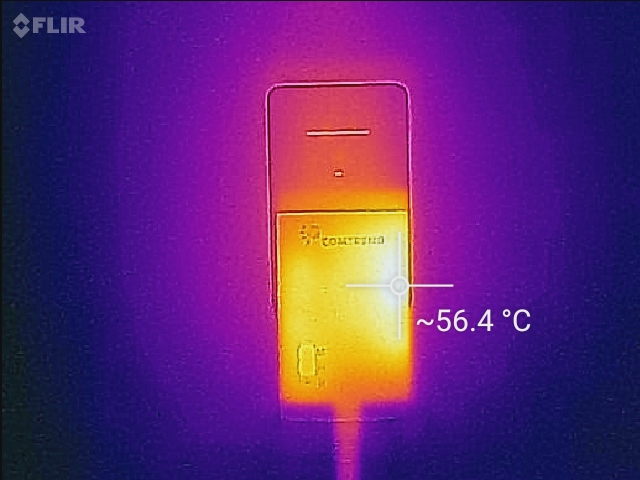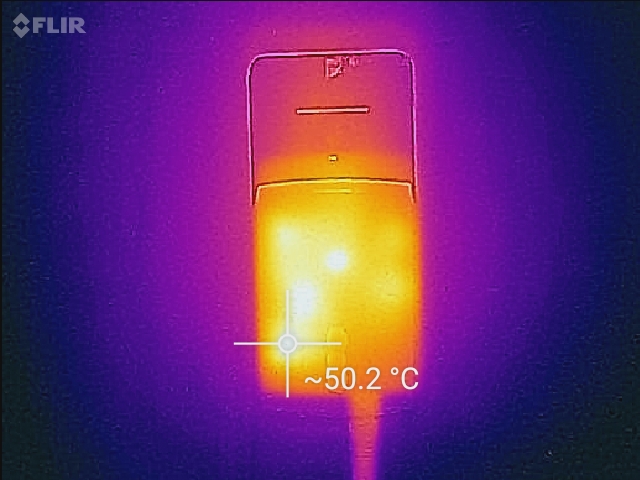Comtrend PG-9172 Powerline Adapter Review: G.hn Gets Primed for Retail Push
by Ganesh T S on May 3, 2016 8:30 AM EST- Posted in
- Powerline Adapters
- Networking
- Marvell
- G.hn
- HomePlug
- Comtrend
Miscellaneous Aspects - Power, Thermals and Coexistence
Powerline adapters tend to get quite warm under sustained loading conditions. The power consumption is also an interesting aspect, since these devices are kept on 24x7. We evaluated these aspects for the Comtrend PG-9172 and the ZyXEL PLA5405. While the master node was left as-is (with the DHCP server NUC connected) in the 'M' location in the floorplan, the other member of the adapter pair was connected to a Ubiquiti Networks mFi In-Wall outlet in the same room as Node C. The In-Wall outlet allows measurement of instantaneous power consumption.
A stress test was set up with iperf servers and clients running on the NUCs at either end. 16-stream TCP benchmarks were processed for 30 minutes from both sides simultaneously.
Under these sustained loading conditions, the G.hn pair was able to maintain 60 Mbps+ uplink and downlink, while the HPAV2 MIMO pair was able to maintain around 40 Mbps
At the end of the 30 minute stress test, thermal photographs of both units were taken using the FLIR One for Android thermal camera.
We find that the G.hn adapter ran hotter (more than 56C) compared to the HPAV2 adapter (around 50C)
The power consumption of the adapters was also recorded under different scenarios. Under stress, the HPAV2 adapter does consume more power than the G.hn adapter. However, the thermal design must be better in the former in order to maintain a lower case temperature. On the other hand, under idle conditions, the disabling of the power saving feature by default in the G.hn adapter results in much higher power consumption compared to the HPAV2 adapter.
| PLC Adapter Power Consumption | ||
| Scenario | Comtrend PG-9172 | ZyXEL PLA5405 |
| Normal (No Traffic) | 3.19 W | 1.98 W |
| Stress Test (TCP) | 3.85 W | 3.97 W |
Coexistence is important if G.hn adapters end up getting installed in apartments with pre-existing HomePlug networks. Marvell has been working on updating the firmware to improve coexistence. Even though our review units were not equipped with the latest coexistence firmware, we decided to test out whether HomePlug and G.hn networks could co-exist. Towards this, we created a HomePlug AV2 network to extend our primary network (192.168.1.0 subnet) and retained the G.hn network described above. The HPAV2 network's master node was connected to a power outlet in the wall adjacent to the G.hn master node.
Traffic in our primary HPAV2 network was restricted to a series of pings (over Wi-Fi to a PC connected to the second powerline adapter). In this scenario, we processed the stress test on the G.hn network. There is a clear loss of bandwidth, and the consistency exhibited in the previous run was no longer present. However, it did manage to stay above 35 Mbps all through. On the HPAV2 side, we lost around 4 packets out of a few thousand. On the whole, our conclusion regarding coexistence is that it works in our limited testing. Future firmware updates might help lessen the impact on the HPAV2 network while also enabling the G.hn network to have better performance consistency.















48 Comments
View All Comments
kamm2 - Wednesday, May 4, 2016 - link
Yeah, 99.99% chance a home built in 1892 with good wiring does not have 1892 wiring. If it was even built with any wiring.extide - Wednesday, May 4, 2016 - link
While I agree with most of what you say, the words 'Occupancy' and 'Flipping' should never be used in the same sentence when talking about homes...kmmatney - Wednesday, May 4, 2016 - link
I would think it would just be easier to use wireless in an older home. With most people having laptops , phones, ipads, etc.. your going to be on wireless most of the time anyways. You can get repeaters easily enough. My home was built in 1999, with ethernet cables wired across the whole house, but it turns out a lot of the connections are not convenient, so I still use mostly wireless.I did use a powerline adapter for one connection, and found it was a bit finicky, and wouldn't work between all plugs (and I'm sure my wiring is fine).
mgrier - Tuesday, May 3, 2016 - link
Definitely. It would rock for a streaming box but I guess those tend to be small USB-powered and use wireless. I'd prefer to have a real outlet needed and avoid cluttering my wifi with video.Murloc - Thursday, May 5, 2016 - link
because the power network in houses is a mess or unknown to the owner and something always ends up not working.Wireless is just a better solution for most people and applications and even that isn't hassle-free.
fazalmajid - Tuesday, May 3, 2016 - link
I am getting spotty performance on a pair of PLA-5405 I use to bridge upper and lower floors in my 1936 house with electrical wiring upgraded in 2006 (odd layout makes Cat5/6unpractical, plaster and lath construction is highly effective at blocking WiFi). I ordered a pair of these and a pair of HomePlug AV2000 Extollo Lansocket 1500 that outperform them in other reviews. G.hn proponents claim it has better noise resistance, I'd like to put that to the test.Guspaz - Tuesday, May 3, 2016 - link
You seem to use the terms "HomeGrid" and "G.hn" interchangeably without ever explaining that they're the same thing. That was very confusing, as for most of the first page of the article, I thought you were talking about three different standards.Valantar - Tuesday, May 3, 2016 - link
I agree. It took me all of the first page to understand that G.hn and HomeGrid were the same thing. No clear link between the two names, and no mention in the introduction. What do the two names mean? Is one a standards organization, while the other is the name of their tech? If so, which is which? And why have two names at all?Guspaz - Tuesday, May 3, 2016 - link
I think adding a single word would solve the problem. Change this:However, despite silicon getting demonstrated at various trade shows, G.hn was unable to get a retail product out for a long time.
To this:
However, despite silicon getting demonstrated at various trade shows, HomeGrid's G.hn was unable to get a retail product out for a long time.
grazapin - Tuesday, May 3, 2016 - link
Yeah that first paragraph drops the names HomePlug, HomeGrid, G.hn and Comtrend with no explanation of how they relate to each other. I picked up most of it from context, but how G.hn fit in was not clear for most of the article. In fact, the only explanation that jumps out at me now is in the very last paragraph: "HomeGrid / G.hn"